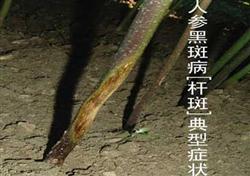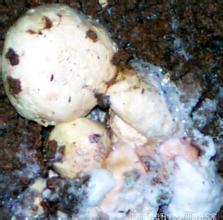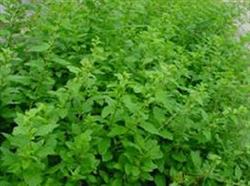Identification and Control of Ginseng Diseases

Ginseng blight 1. Symptoms. Caused by infection of Rhizoctonia solani and Fusarium oxysporum. So that the seedlings can not be unearthed, or invade the stem of the seedlings after they are unearthed, at the junction of dry and wet soil 3cm away from the topsoil. The injured part was light yellowish brown and gradually became dark yellowish brown, forming long sunken spots, which went deep into the stem and rotted, and the enlarged part of the disease showed black-brown annular constriction, which cut off the conducting tissue and made the ginseng seedlings lodge and die. It can be seen that the disease is wrapped around white hyphae adhering to soil particles. two。 Defense. First, the selection of loose soil, sand content in 15-20%, good permeability, strong permeability, easy to increase ground temperature, avoid excessive soil moisture, reduce disease conditions. The second is to use the next year. After ploughing, the soil will be fully decayed and disease resistance will be improved by relaxing for one year. Third, seed mixing. Mix seeds with 95% Lvheng No.1 and 1.5 grams per kilogram. The fourth is to soak the seeds and seedlings. Soak the seeds with 80% Luheng No. 2 800 times solution for 10 minutes for 15 minutes before sowing. Fifth, soil disinfection. Spray the bed with 95% Luheng No. 1 3000 times liquid before sowing. Sixth, after the onset of the disease, 80% Luheng No. 2 600 × 800 liquid spray was used to control the disease. Bounce back Bing 1. Symptoms. Caused by infection by Pythium. In the early stage of the disease, the young stem of ginseng appeared water-immersed dark disease spot, which spread up and down from the topsoil, the dark brown soft rot expanded quickly, the affected area contracted and softened, and finally the plant died. If the humidity of the ginseng bed is too high, the disease part is dense with white cavernous mold. After the dead plant decayed, there was a layer of gray-white mildew on the surface and surrounding soil, namely mycelium. two。 Prevention and treatment. One is to make the ginseng bed well drained, the soil loose, ventilated and transparent, prevent the greenhouse from leaking rain, avoid excessive soil moisture, and reduce the conditions for the disease. The second is to remove the diseased plant immediately to reduce infection. Third, the root of the diseased plant was perfused with 3000 times solution of 95% Luheng No.1. Fourth, after the onset of the disease with 80% Dyson zinc 800 to 1000 times the liquid spray prevention and treatment. Epidemic disease 1. Symptoms. Caused by Phytophthora infection. In the early stage, the disease spot on the leaf was water-immersed, without margin and dark green. When the air humidity is high, the disease part appears yellow-white mildew layer, that is, conidia, the stem is susceptible to water immersion, gradually expand, soften and rot, bacteria often invade and have fishy smell after rotting roots, and white hyphae are often found in the outer skin in the later stage. The disease spread rapidly, and the disease could be seen in the surrounding plants 3-5 days after the central diseased plant was found. two。 Prevention and treatment. First, strengthen field management. Prevent the shed from leaking rain, cover the bed with fallen leaves, create good ventilation and drainage conditions, and prevent the occurrence of epidemic disease. The second is to remove the central diseased plant in time. Spray the disease point with 3000 times liquid of 95% Luheng No.1 to kill the germs. Third, every 10 days in the rainy season, spray 1500mm 2000 times liquid or 58% Ruidu Manganese Zinc wettable powder 800x 1000 times liquid every 10 days. The front and back of the leaf, stem, fruit and bed should be sprayed to prevent the occurrence of diseases. Black spot 1. Symptoms. It is caused by infection of black spot pathogen. At the initial stage of the disease, the leaves had nearly round or irregular water-immersed spots, gradually enlarged brown or dark brown spots, and later became yellowish brown in the center, which was easy to break after drying. They often converge with each other, withering the leaves. The disease spots on stems, leaves and pedicels show dark green oval spots at the initial stage, gradually turn yellowish brown and extend rapidly up and down, the middle depression becomes black, and when the air humidity is high, there is a layer of black mildew, that is, the fruiting body of the pathogen. two。 Prevention and treatment. First, remove the diseased leaves and fruits in time, burn the diseased remains with fire, and eliminate the source of bacteria. Second, ginseng leaves are sprayed with 80% Luheng No.2 600mm 800 times liquid spray every 10 days to prevent the disease. After the onset of the disease, 58% Ruidu Manganese Zinc wettable powder was sprayed with 800-1000 times liquid spray for 2 times 3 times. The stem spot can be cut off with a blade, and Luheng No. 2 can be adjusted into a paste to control the spread of the disease. Anthrax 1. Symptoms. Caused by anthrax infection. In the early stage of the disease, dark green small round or subround disease spots appeared on the leaves, gradually expanded to brown, the center was yellow and white, the edges were clear, sometimes the edges were reddish brown, the center was light brown, and there were concentric wheel lines, black dots on the upper side, easy to break and perforate when dry, easy to rot when it was rainy, and seriously harmful diseased leaves with many and dense spots, and the leaves often fell off from the petiole. two。 Prevention and treatment. The first is to remove the sick and residual body in time and reduce the source of bacteria. The second is to spray 95% Luheng No. 1 3000 times liquid bed disinfection before emergence. Third, after emergence and leaf display, spray 80% Luheng No. 2 600mm 800 times liquid, once every 10 days. After the onset of the disease, 80% Dysen zinc 800 times solution or 45% Dysenamine 800 times solution was sprayed continuously for 2 times for 3 times to control the spread of the disease. Rust rot 1. Symptoms. Caused by the infection of rust rot pathogen. Harmful to the root of ginseng, the disease spot is yellow-white spot at the initial stage, gradually expands and fuses, irregularly shaped rust-like yellow-brown spot, the edge is slightly raised, the center is slightly sunken, and the boundary is clear with the healthy part. in serious cases, it leads to dry rot and soft rot, which makes the root of ginseng rot, cannot be used medicinally or has no yield. After the ginseng root was infected, the aboveground parts showed short plants, the leaves did not spread, and reddish-brown or yellowish-brown spots appeared on the leaves, so that all of them turned red and withered and died. two。 Prevention and treatment. First, the selection of high terrain, slightly larger slope, good drainage of the land, reduce the incidence of conditions. The second is to spray the bed surface with 3000 times liquid of 95% Luheng No.1 for soil treatment. Third, select the disease-free and injury-free seedlings when transplanting, soak the seedlings with 80% Luheng No. 2 800 times solution for 10 minutes for 15 minutes, dry slightly before transplanting. Fourth, plastic surgery under the beard, 80% Luheng II into a paste, smear the injured area to prevent the disease. Sclerotiorum disease 1. Symptoms. Caused by Sclerotinia sclerotiorum infection. Mainly harms the root, at the initial stage of infection, there are a few white velvet mycelia on the outside, and the interior is in a state of soft rot, and then irregular black mouse fecal grains are formed, which is sclerotia. The disease spread very rapidly, and the early aboveground part was almost the same as the healthy plant, and it was difficult to identify in the early stage. When the aboveground stems and leaves wilted, the ginseng root was rotten. two。 Prevention and treatment. First, choose the land with high terrain and good drainage, loosen the soil early and loosen the soil frequently to increase the air permeability of the soil. The second is to sterilize on the bed of 1 square meter with 10-15 grams of Sclerotinia and carbendazim before planting. The third is to control the spread of the disease by spraying Sclerotinia sclerotiorum 500 ~ 800 times or 80% Dysen zinc 800 times.
- Prev

Early prevention of dry bubble disease in cultivated Pleurotus ostreatus
Dry bubble disease is one of the main diseases of Pleurotus ostreatus. The pathogen has formed infection in the germ stage of Pleurotus ostreatus, and grows synchronously with the hyphae of Pleurotus ostreatus, but does not show symptoms temporarily, and the mycelium invades in the stage of mushroom emergence. The injured fungus lid appears dark brown sunken and attached with white powder; the stalk is uneven and malformed; the diseased mushroom is anhydrous.
- Next

New management technology of ginseng shading net shed
1. Selection of varieties: there are mainly two varieties of Chinese wolfberry: fine-leaf Chinese wolfberry and big-leaf Chinese wolfberry. Fine-leaf Chinese wolfberry with thick meat and strong flavor is the main variety in our city. 2. Cutting propagation: vegetable Lycium barbarum does not blossom and bear fruit, and cuttings are used to propagate every year. Protected cultivation is usually cut in the middle of September. When breeding,.
Related
- Fuxing push coffee new agricultural production and marketing class: lack of small-scale processing plants
- Jujube rice field leisure farm deep ploughing Yilan for five years to create a space for organic food and play
- Nongyu Farm-A trial of organic papaya for brave women with advanced technology
- Four points for attention in the prevention and control of diseases and insect pests of edible fungi
- How to add nutrient solution to Edible Fungi
- Is there any good way to control edible fungus mites?
- Open Inoculation Technology of Edible Fungi
- Is there any clever way to use fertilizer for edible fungus in winter?
- What agents are used to kill the pathogens of edible fungi in the mushroom shed?
- Rapid drying of Edible Fungi

